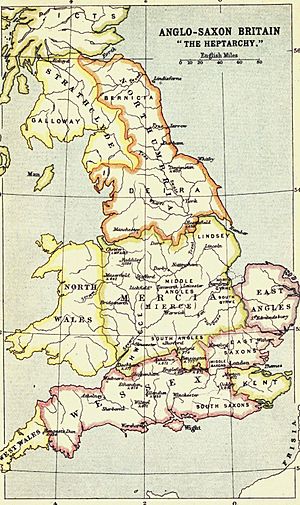Heptarchy facts for kids
The Heptarchy was a name given to seven important Anglo-Saxon kingdoms in early English history. The word "Heptarchy" comes from two Greek words: hepta meaning "seven" and arche meaning "realm" or "rule". These kingdoms were Northumbria, Mercia, East Anglia, Essex, Kent, Sussex, and Wessex. Over time, these Anglo-Saxon kingdoms joined together to form the Kingdom of England. People have used the term "Heptarchy" since the 16th century. It refers to both the seven kingdoms themselves and the period when they existed.
Contents
What Was the Heptarchy?
The idea of seven main kingdoms, or a "heptarchy," was first suggested by the English historian Henry of Huntingdon in the 12th century. He listed these seven Anglo-Saxon kingdoms in his book Historia Anglorum (History of the English People).
However, another important historian named Bede had a different idea. He believed that some kingdoms were more powerful than others at different times. Bede made a list of kings who ruled over the other kingdoms. The River Humber often acted as a border between these powerful kingdoms. Northumbria (which included Deira and Bernicia) was the main kingdom in the north. The other powerful kingdoms were in the south of England.
The actual word "Heptarchy" was first used in the 16th century by William Lambarde. His map from 1568 is the earliest known time the word was used.
The Kingdoms Were Not Equal
The term "Heptarchy" sometimes makes it sound like the seven kingdoms were all equal. But this was not true. From the 6th to the 9th centuries, these were simply kingdoms created by Germanic invaders and their families. There was little equality between them.
Northumbria, Mercia, and Wessex were usually the strongest kingdoms. They often controlled the others. Over time, the number of independent kingdoms slowly decreased. The Heptarchy period mostly ended when the Vikings arrived in England. The term "Heptarchy" was very popular among scholars from the 16th to the 19th centuries. It is still sometimes used today.
What Were Bretwaldas?
Bede first listed seven kings who held great power over the other kingdoms in England. These powerful rulers were called "Bretwaldas." The Anglo-Saxon Chronicle later added an eighth Bretwalda to the list.
Here are the kings known as Bretwaldas:
- Aelle, King of the South Saxons (Sussex)
- Ceawlin, King of the West Saxons (Wessex)
- Aethelbert, King of Kent
- Raedwald, King of East Anglia
- Edwin, King of Northumbria
- Oswald, King of Northumbria
- Oswiu, King of Northumbria
- Egbert, King of the West Saxons (Wessex)
Two kings from Mercia in the 8th century are also often seen as Bretwaldas:
- Aethelbald, King of Mercia
- Offa, King of Mercia
The Seven Kingdoms of the Heptarchy
The seven kingdoms that made up the Heptarchy were:
- East Anglia
- Mercia
- Northumbria, which included the smaller kingdoms of Bernicia and Deira
- Wessex
- Essex
- Kent
- Sussex
See also
 In Spanish: Heptarquía anglosajona para niños
In Spanish: Heptarquía anglosajona para niños


